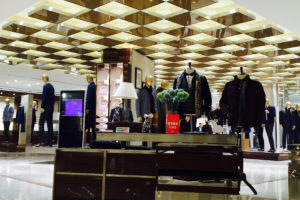 Addiction is a big factor is some shoplifters’s lives. They steal to then sell the stolen merchandise to be able to purchase drugs and alcohol. Employees with a drug addiction problem are dangerous to a retail store, specially those employees that are given a position of power, or have some type of freedom with merchandise, cash or even the security of the store.
Addiction is a big factor is some shoplifters’s lives. They steal to then sell the stolen merchandise to be able to purchase drugs and alcohol. Employees with a drug addiction problem are dangerous to a retail store, specially those employees that are given a position of power, or have some type of freedom with merchandise, cash or even the security of the store.
Employees that feel as deserving employees that are not being properly compensated can be a liability to a retail store as well. Anger, bad attitudes, and eventually theft can be a big problem for the store where they are employed.
Retailers and employers in the United States and around the globe loose billions of dollars to shoplifting and employee theft every year. Periodic inventory of employees, merchandise and security of the store are not only necessary but imperative to the health of the business.
If as an owner, any part of the proper management of the store is left unattended, the results can be catastrophic.
For more about this and other topics follow the links below.
Your Loyal, Hardworking, and Intelligent Employee Might Be Stealing From Your Business
Most perpetrators are middle-aged, longtime employees who never take vacation, says new study.
Last June, Linda Clark, a 68-year-old bookkeeper, who worked for a credit union in Iowa, plead guilty to embezzling almost $2.5 million from her employer between 1978 until she resigned in 2015.
The SCICAP Credit Union in Chariton, Iowa, had to liquidate due to Clark’s 37-year-long scheme, during which she diverted small sums of money into her bank account as well as those of her children.
Clark fits the profile of the average embezzler, according to a studythat looked at over 400 embezzlement cases in federal court, conducted by insurance provider Hiscox. The study found the average embezzler to be a small-business, middle-aged employee who works in the accounting and finance department. Perps were female in 41 percent of the cases.
Clark’s scheme went on longer than average, but the majority of schemes, 28.7 percent, go on for five years with an average theft amount of $2.2 million. For schemes that last 10 years, the average loss hits $5.4 million.
NEW YORK, NY, Aug. 23, 2017 (GLOBE NEWSWIRE) — Hiscox, the international specialist insurer, today released the 2017 Hiscox Embezzlement Study™, an examination of employee theft in the US. The findings reveal that US businesses impacted by employee theft lost an average of $1.13 million last year. Small and mid-sized companies (fewer than 500 employees) continue to be disproportionally victimized by employee theft, representing approximately 68 percent of cases.
This is the third annual Hiscox Embezzlement Study, which examines employee theft cases that were active in the US federal court system in 2016.
“There is a necessary level of trust between employees and their employer that is required of successful businesses,” said Doug Karpp, Crime & Fidelity Product Head at Hiscox. “When there is a breach in that trust because an employee or executive steals, it can have a significant impact on the entire organization both financially and emotionally. Business owners and executives need to make the shift from blind trust to intelligent trust to ensure they are able to spot and prevent employee theft.”
 How often does it happen? You are in front of your television watching your favorite college football team playing a game and your spouse starts talking to you about their day or what you need from the grocery store. Then suddenly the conversation takes a nasty turn and you are asked for input about the conversation you weren’t really engaged in. The textbook reply, “Yes Dear” or
How often does it happen? You are in front of your television watching your favorite college football team playing a game and your spouse starts talking to you about their day or what you need from the grocery store. Then suddenly the conversation takes a nasty turn and you are asked for input about the conversation you weren’t really engaged in. The textbook reply, “Yes Dear” or We’ve all been there, we are on our way to work and the next thing you know you come to a standstill. Cars backed up as far as you can see and no one is going anywhere. The clock is ticking away and you begin to worry knowing you are going to be late getting to the office. You look for a side street to try to get out of the mess then, someone with a little bit of guts and a four-wheel drive truck pulls onto the shoulder of the road and speeds by everyone to get to their destination. Everyone gets to where they are going but some people are determined not to let obstacles get in their way and they take the fast track to get there. They went the same route they just overcame the obstacles that would get in their way.
We’ve all been there, we are on our way to work and the next thing you know you come to a standstill. Cars backed up as far as you can see and no one is going anywhere. The clock is ticking away and you begin to worry knowing you are going to be late getting to the office. You look for a side street to try to get out of the mess then, someone with a little bit of guts and a four-wheel drive truck pulls onto the shoulder of the road and speeds by everyone to get to their destination. Everyone gets to where they are going but some people are determined not to let obstacles get in their way and they take the fast track to get there. They went the same route they just overcame the obstacles that would get in their way. Turnover for many businesses can be a real headache. You take the time to post job ads, review job applications, set up interviews and then conduct the interviews. Your new hire starts and within a couple of weeks they quit. It happens far too many times and it is a pain. Why did the person quit? Did they have a propensity for job hopping already and you missed it on the job application? Did they start stealing from you and got enough money or merchandise and quit before you caught on to their schemes? Perhaps it was a young employee on their first job and they wanted more weekends and night shifts off so they could “hang out” with their friends. All of these are reasons for high turnover in retail stores especially. Lose too many people at once and it can cripple your business, stretch the staff you currently have and it may potentially lead to more employees quitting.
Turnover for many businesses can be a real headache. You take the time to post job ads, review job applications, set up interviews and then conduct the interviews. Your new hire starts and within a couple of weeks they quit. It happens far too many times and it is a pain. Why did the person quit? Did they have a propensity for job hopping already and you missed it on the job application? Did they start stealing from you and got enough money or merchandise and quit before you caught on to their schemes? Perhaps it was a young employee on their first job and they wanted more weekends and night shifts off so they could “hang out” with their friends. All of these are reasons for high turnover in retail stores especially. Lose too many people at once and it can cripple your business, stretch the staff you currently have and it may potentially lead to more employees quitting. Retail shelving along with store design has a huge impact on shoplifting losses. Typically a shoplifter likes and needs privacy even if only for a moment. So why not keep that in mind when designing or remodeling your store. Your shelving and isles can work for you by simply considering several factors.
Retail shelving along with store design has a huge impact on shoplifting losses. Typically a shoplifter likes and needs privacy even if only for a moment. So why not keep that in mind when designing or remodeling your store. Your shelving and isles can work for you by simply considering several factors. Growing up did you ever do something dumb and your mom or your dad would ask you, “What were you thinking?” Having lived in south for the past 32 years I have learned of the local colloquialism when someone does something stupid, “Didn’t your momma teach you better?” Unfortunately, as a young boy I did a lot of dumb things making me wonder if my brain developed a lot later in life than most people. For example, I had a propensity for walking behind batters warming up to go to the plate for my father’s teen baseball teams. I ended up with more than one fat lip from my stupidity…obviously not learning the lesson the first time. I had a fascination with electrical outlets and wires and old rotary dial telephones…I won’t go into details but no they didn’t work when the wires were pushed into the outlet, I was not injured but I had one very busy guardian angel.
Growing up did you ever do something dumb and your mom or your dad would ask you, “What were you thinking?” Having lived in south for the past 32 years I have learned of the local colloquialism when someone does something stupid, “Didn’t your momma teach you better?” Unfortunately, as a young boy I did a lot of dumb things making me wonder if my brain developed a lot later in life than most people. For example, I had a propensity for walking behind batters warming up to go to the plate for my father’s teen baseball teams. I ended up with more than one fat lip from my stupidity…obviously not learning the lesson the first time. I had a fascination with electrical outlets and wires and old rotary dial telephones…I won’t go into details but no they didn’t work when the wires were pushed into the outlet, I was not injured but I had one very busy guardian angel. Loss Prevention Officers and Managers catch shoplifters and dishonest employees. That is a common perception and in some stores it may be a true picture of what Loss Prevention departments do, with the additional caveat that they may have uniformed people who conduct receipt checks. If this is all that the department does it can be hard to sell store managers on the value of having them on staff if the budget for them comes directly from the store. It is even more difficult for small, independent retailers to justify hiring a Loss Prevention Officer although if the store is in a high crime area they may contract a security guard. There was a time when there was an “us versus them” mindset between store managers and Loss Prevention teams. Over time some larger companies have focused their Loss Prevention teams more on operational issues. For example, I worked for a company that had Loss Prevention conduct food product out of date audits. Their position was that this was a safety issue so it fell to the Loss Prevention team. I had no problem doing the audits, but as I looked at the amount of out of date items I was finding I had to question what the freight team was doing when they were stocking. Who was auditing their work because there were a lot of FIFO (First In First Out) issues I was identifying that were causing out of date problems.
Loss Prevention Officers and Managers catch shoplifters and dishonest employees. That is a common perception and in some stores it may be a true picture of what Loss Prevention departments do, with the additional caveat that they may have uniformed people who conduct receipt checks. If this is all that the department does it can be hard to sell store managers on the value of having them on staff if the budget for them comes directly from the store. It is even more difficult for small, independent retailers to justify hiring a Loss Prevention Officer although if the store is in a high crime area they may contract a security guard. There was a time when there was an “us versus them” mindset between store managers and Loss Prevention teams. Over time some larger companies have focused their Loss Prevention teams more on operational issues. For example, I worked for a company that had Loss Prevention conduct food product out of date audits. Their position was that this was a safety issue so it fell to the Loss Prevention team. I had no problem doing the audits, but as I looked at the amount of out of date items I was finding I had to question what the freight team was doing when they were stocking. Who was auditing their work because there were a lot of FIFO (First In First Out) issues I was identifying that were causing out of date problems.
 We make decisions each and every day that have consequences. We set our alarm clocks and when they go off we choose to do the right thing and get up so we have time to prepare for work properly, showering, grabbing a bite to eat, sipping a cup of coffee or two and saying good-byes to our family. It is possible we may choose to do the wrong thing, hit the snooze button and get that 5 extra minutes of sleep but there is a cost associated with it. That five minutes easily turns to fifteen minutes, showers go by the wayside, we grab the first thing we can find in the closet (or hamper), our socks wind up not matching and if we are fortunate we grab a cup of coffee in a travel cup and hope it doesn’t spill on us as we jog/stumble to the car.
We make decisions each and every day that have consequences. We set our alarm clocks and when they go off we choose to do the right thing and get up so we have time to prepare for work properly, showering, grabbing a bite to eat, sipping a cup of coffee or two and saying good-byes to our family. It is possible we may choose to do the wrong thing, hit the snooze button and get that 5 extra minutes of sleep but there is a cost associated with it. That five minutes easily turns to fifteen minutes, showers go by the wayside, we grab the first thing we can find in the closet (or hamper), our socks wind up not matching and if we are fortunate we grab a cup of coffee in a travel cup and hope it doesn’t spill on us as we jog/stumble to the car. 